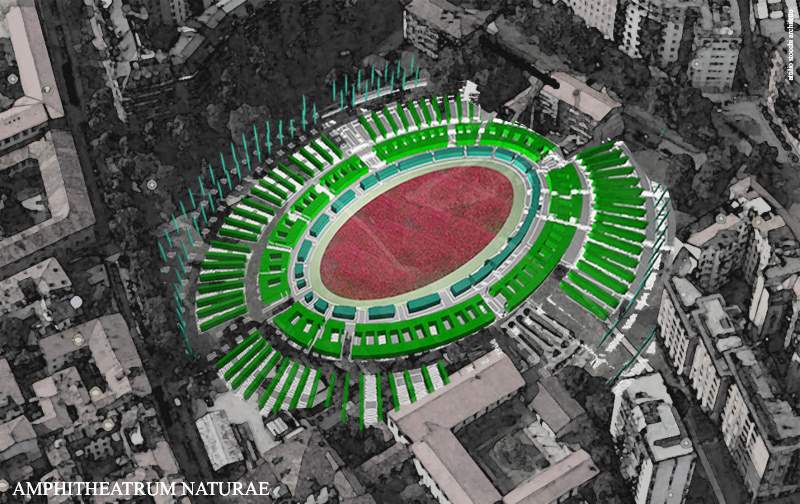Milan will get its Colosseum back. Work on the Amphitheatrum Naturae gets underway.
Work will start in early December in Milan on the Amphitheatrum Naturae project, desired by the Superintendency of the Lombard capital (the idea is by Superintendent Antonella Ranaldi) and presented in September 2017. The project will revive the city’s archaeological area by bringing the ancient Milanese amphitheater back to life: Milan will therefore see its “Colosseum” again, but it will be a Colosseum... green. The layout of the ancient Roman structure will in fact be recreated only with trees and plants: it will be an elliptical garden of about 22,400 square meters, which will faithfully trace the plan of the amphitheater of Mediolanum, destroyed in the sixth century by the Goths who invaded the city. The central area affected by the “green archaeology” work is that of the Roman Amphitheater Park (opened in 2004), just behind the columns of San Lorenzo.
Only a few remains survive today of the ancient amphitheater, visible in the Park. It was an imposing structure: with an elliptical layout of 155 by 125 meters, it was the third largest amphitheater in the entire empire, after the Colosseum and the amphitheater at Capua. It was built between the 2nd and 3rd centuries: it was used for about a century, then abandoned and used as a quarry (the stone blocks with which the amphitheater was built were partly used for the construction of the nearby basilica of San Lorenzo), then finally demolished during the invasion of the Goths.
The area, owned by the municipality, has been granted on a free loan to the Superintendence, which will oversee the construction work on the green amphitheater. The latter will probably be completed as early as 2019. As the Corriere di Milano reports today, next week work will begin on cleaning up the area of the Park facing Via Conca del Naviglio and the area facing Via dell’Arena (some ruins will also be demolished). The Park area will include the lands of the former Riva Nursery going to extend over the area of more than 22 thousand square meters mentioned above (and which, moreover, will make it possible to connect the Amphitheater Park to that of the Basilicas: a sort of continuous park will thus be created, covering an area of 100,000 square meters). Excavations will then begin in February and, based on the results, planting of the greenery that will recreate the Milanese “Colosseum” will begin. The space on which thearena once stood, that is, the ground where performances took place, will return to its ancient function: it will in fact be left free and will be able to host performances, exactly as it did almost two thousand years ago. The plants (boxwood, privet, myrtle and cypress) were chosen based on descriptions of the plants that adorned the gardens of the time. They will be arranged on a double ellipse of one hundred and two cypress trees that will resemble the amphitheater’s cavea. The operation will be sponsored by private funding in the amount of 1.25 million euros: the public-private partnership will be highlighted with a billboard on Edmondo De Amicis Street.
The models to which the new Amphitheatrum Naturae looks are lofty. “The care, custody, and maintenance of sites,” Antonella Ranaldi had specified in the presentation of the project, “can dialogue with new designs, in the symbiosis between ruins and nature, landscape, romantic, and architectural that finds its premises in Vedutism, in the Roman experiences of Giacomo Boni at the Roman Forum in the early nineteenth century, of Antonio Munoz at the Temple of Venus and Rome, and of Corrado Ricci for the exedrae arborea of pine trees at the beginning of the Via dei monti and at the Via del mare, at the roots of the very cognition of archaeological park extended from the Capitol to the Colosseum to the Appian Way.” Thus, the viridarium that is to be created will revitalize "the archaeological park of the Roman Amphitheater in Milan, to make it an unprecedented Amphitheatrum viridans, with arboreal elements of ancient topiary (boxwood, myrtle and cypresses): a large elliptical garden to delineate the sedime and the shape of the plant of the lost amphitheater."
Thus, 2019 will be the year when Milan will see the Colosseum again, albeit in a...vegetable format. Below are some images of the project, released by the Milan Superintendency.
 |
 |
 |
| Milan will get its Colosseum back. Work on the Amphitheatrum Naturae gets underway. |
Warning: the translation into English of the original Italian article was created using automatic tools. We undertake to review all articles, but we do not guarantee the total absence of inaccuracies in the translation due to the program. You can find the original by clicking on the ITA button. If you find any mistake,please contact us.





























